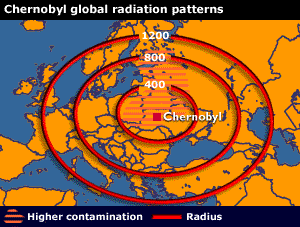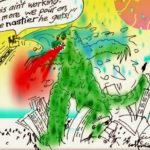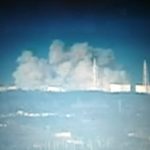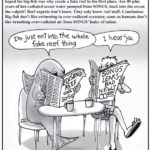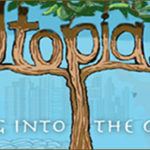Right after Chernobyl blew, Edward Teller said: “The chances of a real calamity at a nuclear power station are infinitesimally small. But should it happen, the consequences are impossible to imagine.” Now after Japan’s Fukushima disaster, radiation continues to spread across the Pacific to North America with unimaginable consequences.
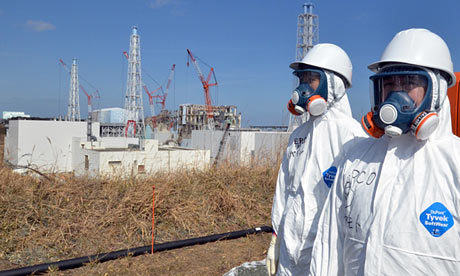

Radiation Hitting the Streets of LA
By Dr. Mark Sircus, from Dr. Sircus’ Blog, International Medical Veritas Association
Right after Chernobyl blew its top, Edward Teller said on the ABC Evening News in late April 1986, “The chances of a real calamity at a nuclear power station are infinitesimally small. But should it happen, the consequences are impossible to imagine.” The plume from the burning graphite at Chernobyl initially traveled in a northwest direction toward Sweden, Finland and Eastern Europe, exposing the public to levels up to 100 times the normal background radiation.
Hope Burwell wrote, “On my first trip to Chernobyl in November 2000, I spent three days touring schools in Cherikov and the even more contaminated areas of the Mogilev district. Then we traveled to children’s hospitals in Minsk. What I saw there still shows up in nightmares: children with eyes in the sides of their heads, and children with no eyes at all, children with fingers that look like toes and children whose genitals are so poorly formed one can’t determine their sex. Those nightmares are audible with infant wails like the cries of wounded wild animals.”
In her widely read essay Burwell reported that 23% of Belarus was contaminated with Chernobyl’s fallout, 32,592 square miles, more land than six eastern states combined. The average level of contamination on the polluted territories, 37 curies (Ci) per square kilometer, is notated scientifically as 37 Ci/km2. The International Atomic Energy Agency (IAEA) set the “safe for residency limit” at a maximum of 5 Ci/km2. Eighty-eight percent of contaminated Belarus is 111-370 times more contaminated than that.
Western predictions of Chernobyl’s consequences were based on Hiroshima-Nagasaki data, and on the then-current belief that iodine-131 had a low carcinogenic potential. But within a year after the accident, Belarusan scientists reported an increase in a rare childhood thyroid cancer to 5,000 times its spontaneous occurrence in “clean” countries.
From Dr. Gabriel Cousens: Research suggests that one milligram of iodine for children and 5 milligrams for adults would reduce the amount of radioactive iodine from direct I-131 exposure accumulated in the thyroid by 80%. Other high iodine foods are swiss chard, turnip greens, wild garlic and onion, watercress, squash, mustard greens, spinach, asparagus, kale, citrus foods, watermelon, and pineapple. Too much iodine may cause overstimulation of the thyroid. (If one is being treated for hyperthyroidism or cardiovascular disease one needs to contact a physician about how much iodine they should take.)
According to the 2000 report on Minsk’s United Nations Development Program (UNDP), life expectancy in Belarus in the 1960s was almost level with that in Western Europe. By 1999, 13 years after Chernobyl, it had fallen 12-14 years for men and 7-9 years for women. A baby boy born in rural Belarus today can expect to live 59 years.
But they may be very hard years. Nearly half of Belarus’s teenagers have serious health problems. Of those graduating from high school, 45-47% have physical disorders like gastrointestinal anomalies, weakened hearts, and cataracts; 40% of them have chronic “blood disorders” and malfunctioning thyroids. The number of handicapped adolescents has tripled in the last decade.
Fukushima Radiation Fallout Concentrating on the US West Coast
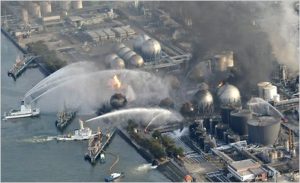
From Dr. Cousens: The second action in the protection against radiation exposure is that of chelation. Certain foods actively draw the radioactive materials to them and pull them out of the body via the bowel and kidney excretion process. An important chelator for pulling radioactive material out of the system is sodium alginate. Sodium alginate reduces the amount of strontium-90 absorbed by the bone by 53-80%. Sea vegetables are high in this natural chelator. The kelp family contains the most sodium alginate. It includes kelp, arame, wakame, kombu, and hijiki.
No one wants to imagine the future and what will happen even if the situation does not get worse. Radiation is pouring out of Fukushima and that radiation is hitting the streets of Los Angeles quite hard. In April 2012 environmental journalist and LA Weekly contributor Michael Collins, an independent who has tested over 1500 samples since the Fukushima earthquake of 2011, was shocked to find that radiation levels in the falling rain over L.A. in March 2012 measured five times above normal.
A March 6th test of a HEPA filter recorded radiation levels 668% or 6.68 times the normal background radiation levels. This test took place 43 days after initial tests and shows a 130% increase since January 22nd 2012. “The California Highway Patrol considers anything over three times background, 300% of background above, a trigger level to a hazardous materials situation,” reported the EnviroReporter.
Our last HEPA filter measurements January 22 produced some astonishing results. Doing a spot test on the Honeywell barrel-style filter and a Kenmore Plasmawave, we found radiation ~351% of normal background. The machines had been running for 42 days. The combined aggregate dust came in even hotter at 538% of normal background radiation at Radiation Station Santa Monica.
Now 43 days later the dust was a lot hotter. A spot test was ~377% of the previous background. Then we vacuumed out the filters with a HEPA filter Eureka vacuum cleaner and tested the aggregate. The March 6 test of the combined dust came in at a sizzling 668% of background or 6.68 times normal. Since the last testing period, the radiation detected has risen another 130% indicating a continued upward trend.
Thus radiation is rising in Los Angeles as it is in many places in the northern hemisphere. For some reality checking, we have the New York Times saying that, “The amount of radioactive materials released in the first days of the Fukushima nuclear disaster was almost two and a half times the initial estimate by Japanese safety regulators, the operator of the crippled plant said in a report released on the 24th of May, 2012.
“The operator, the Tokyo Electric Power Company, said the meltdowns it believes took place at three reactors at the Fukushima Dai-ichi plant released about 900,000 terabecquerels of radioactive substances into the air during March 2011. The accident, which followed an earthquake and a tsunami, occurred on March 11. The latest estimate was based on measurements suggesting the amount of iodine-131 released by the nuclear accident was much larger than previous estimates, the utility said in the report. Iodine-131 is a fast-decaying radioactive substance produced by fission that takes place inside a nuclear reactor. It has a half-life of eight days and can cause thyroid cancer.”
The newly released information just adds insult to injury to not only the Japanese but everyone on the west coast of North America, then onward across the plains to the east coast and then Europe. There are literally a billion people that have not been told the extent of the accident or the risks it posed directly for them.
Radiation Risk?
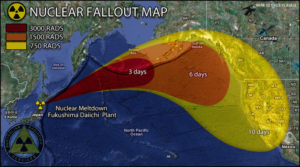
Radiation can damage our bodies by breaking the chemical bonds in our cells. The amount of damage done depends on how much radiation we are exposed to. This in turn depends on how much radioactive material is present in our environment, our food and so on. So it is important to have some way to talk about amounts of radiation. This is what the unit becquerel is for.
“The greatest human experiment with radiation exposure is taking place in the Ukraine and Byelorussia, where much of the 50 million curies the Soviet government says were released by the 1986 accident at Chernobyl is being felt… Chernobyl legacy could include hundreds of thousands of additional cancer deaths… Current estimates predict anything from 14,000 to 475,500 deaths worldwide from Chernobyl.” (A curie measures the intensity of radiation and is equal to 37 billion disintegrations per second. As a reference point, the Hiroshima and Nagasaki bombs released an estimated one million curies.)
If we translate what the New York Times is saying in terms of radiation released in the first 20 days, 900,000 terabecquerels translates into 27 million curies. It is over a year later and no one knows or is saying how much aggregate radiation has been released but we can imagine it’s a staggering amount.
From Dr. Cousens: Foods containing chlorophyll have long been known to protect against radiation. Research has found that cabbage, leafy green vegetables, spirulina, chlorella, wheatgrass, any sprouts, and blue-green algae all reduce the effects of radiation. Soy miso according to post-Hiroshima research, was shown to increase resistance to radiation amongst laboratory mice by five times. Beets protect against the uptake of plutonium-238, -239, iron-55, and -59. Bee pollen is another potent antiradiation food.
One curie is the amount of radiation equal to the disintegration of 37 billion atoms—37 billion becquerels—per second. It is a very large amount of radiation. We multiply these amounts (27 million curies times 37 billion radioactive atoms) and we are back to just a little more than our 900,000 terabecquerels… all the way up to 999,000,000,000,000,000 becquerels, which translates into 999,000,000,000,000,000 nuclear particles decaying in the first 20 days of the Fukushima nuclear nightmare.
TEPCO has reported on what happens when it opens doors in Fukushima. An estimated 1.6 billion becquerels of radioactive materials were released, compared with 500 million becquerels when the double doors of the building of reactor No. 1 were opened one day in May.
So let’s go back to Belarus where the average level of contamination on the polluted territories was 37 Ci/km2 and the maximum safe limit for residency is 5 Ci/km2. We had 27 million curies released in the first 20 days and that would contaminate an area of approximately five million square kilometers if distributed equally. Of course that never happens as we can see in the fallout patterns surrounding Chernobyl. It can be assumed that the worst of the radiation was released in the first month with the complete meltdown of multiple reactor cores and the destruction and probably vaporization of spent-fuel rods.
Radioactive News
Health authorities continue to insist that there are no health risks involved, but The Huffington Post tells us that bluefin tuna caught in California last August showed radiation levels that were ten times the norm, according to a new paper from the Proceedings of the National Academy of Sciences journal. Scientists believe that the radiation—in the form of the isotopes caesium-137 and caesium-134—came from the Fukushima Dai-ichi nuclear disaster that began in March of 2011.
In addition, radioactive debris is already being found on West Coast shores as far as Washington State and is expected to continue to be washed up in the next three years.
Dr. Mark Allan Sircus, Ac., OMD, DM (P)
Director International Medical Veritas Association
Doctor of Oriental and Pastoral Medicine
http://publications.imva.info/
http://blog.imva.info
See Also: Holistic Approach to Overcoming Radiation – Dr. Gabriel Cousens – WilderUtopia


